Repair help
What Causes White Residue after Washing Clothes?
AZparts Team
Updated on July 17, 2025
8 min read
White residue on freshly washed clothes can be frustrating and puzzling for homeowners. This common laundry problem occurs when detergent, fabric softener, or mineral deposits fail to rinse away completely during the wash cycle. Understanding the root causes of white residue after washing clothes is essential for maintaining clean, fresh-smelling laundry and extending the life of your garments. At AZParts, we specialize in providing genuine replacement parts for washing machines and other appliances, helping you resolve these issues effectively.
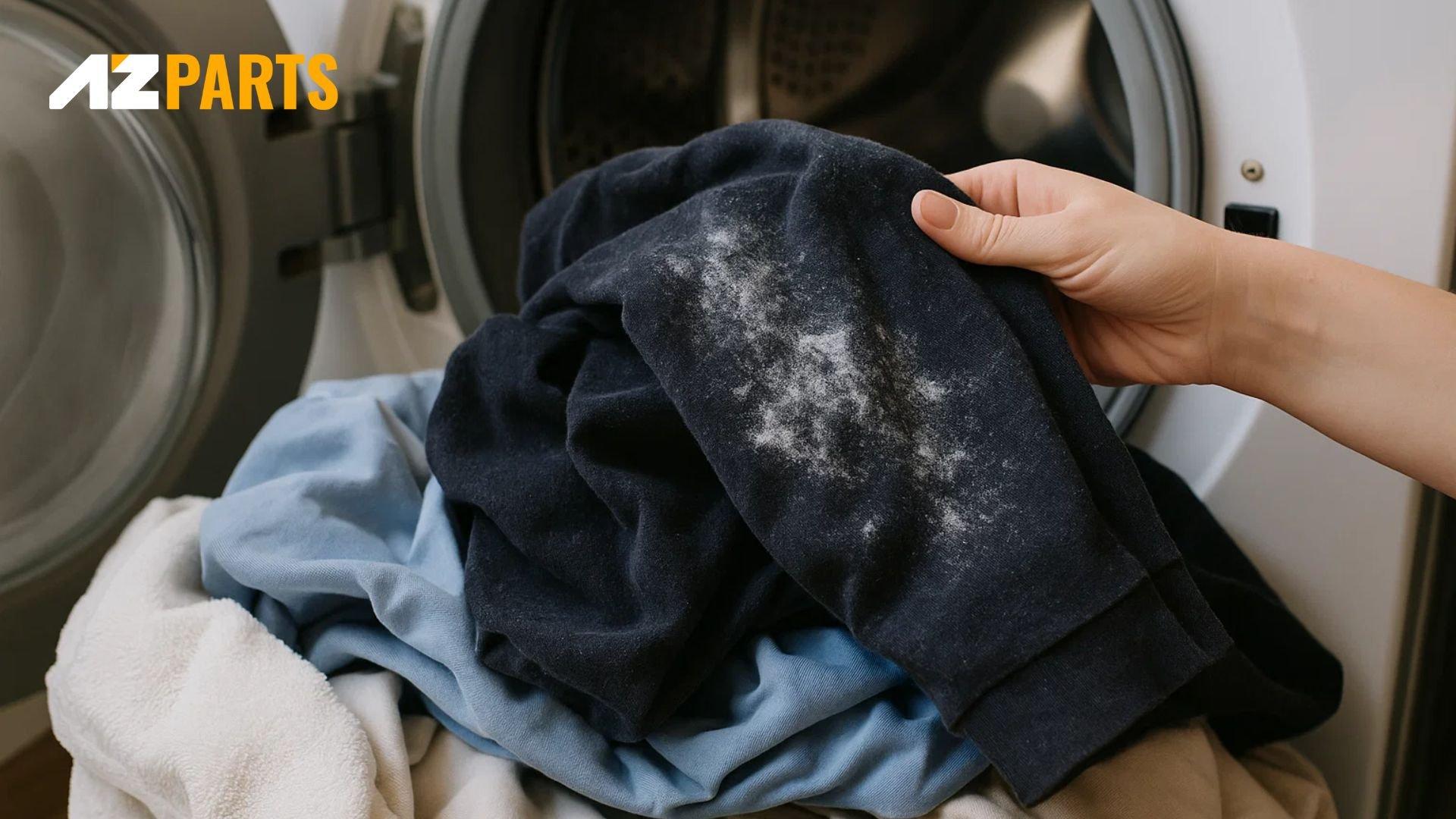
1. What Causes the White Residue On Clothes?
1.1. Too Much Detergent
When you add more detergent than necessary, the washing machine cannot effectively rinse away all the soap during the rinse cycle. This excess detergent clings to fabric fibers, creating visible white streaks or powdery residue on your clothes. Modern high-efficiency detergents are concentrated and require smaller amounts than traditional formulas. Following the manufacturer's recommended dosage based on load size and soil level prevents detergent buildup and ensures optimal cleaning performance.\
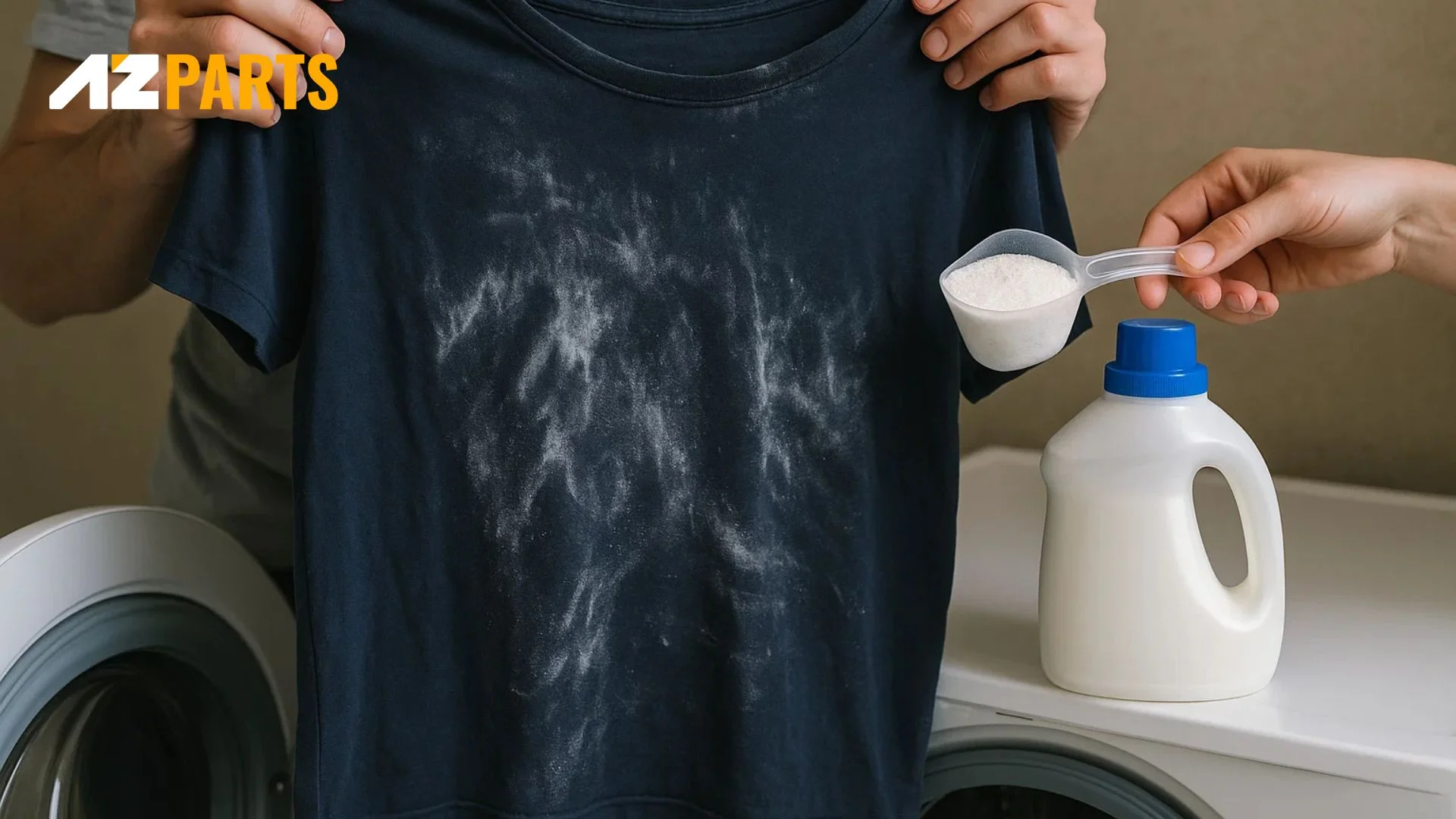
Using too much amounts of detergent can cause the white residue (Source: AZParts)
1.2. Overloaded Washer
Cramming too many clothes into your washing machine prevents proper water circulation and detergent distribution. When garments are packed tightly together, water and detergent cannot flow freely through the fabrics, leading to inadequate rinsing. This restricted movement allows detergent to accumulate in fabric folds and creases, resulting in white residue formation. Additionally, overloading reduces the mechanical action needed to remove soil and detergent from clothes. Washing smaller loads allows for better water movement and more thorough rinsing cycles.
1.3. Undissolved Detergent
This problem commonly occurs when using cold water settings, as powder detergents require warmer temperatures to dissolve properly. Hard water conditions can also interfere with detergent dissolution, as minerals bind with soap molecules and prevent them from dissolving effectively. Pre-dissolving powder detergent in warm water before adding it to the wash cycle ensures complete dissolution and prevents residue formation.
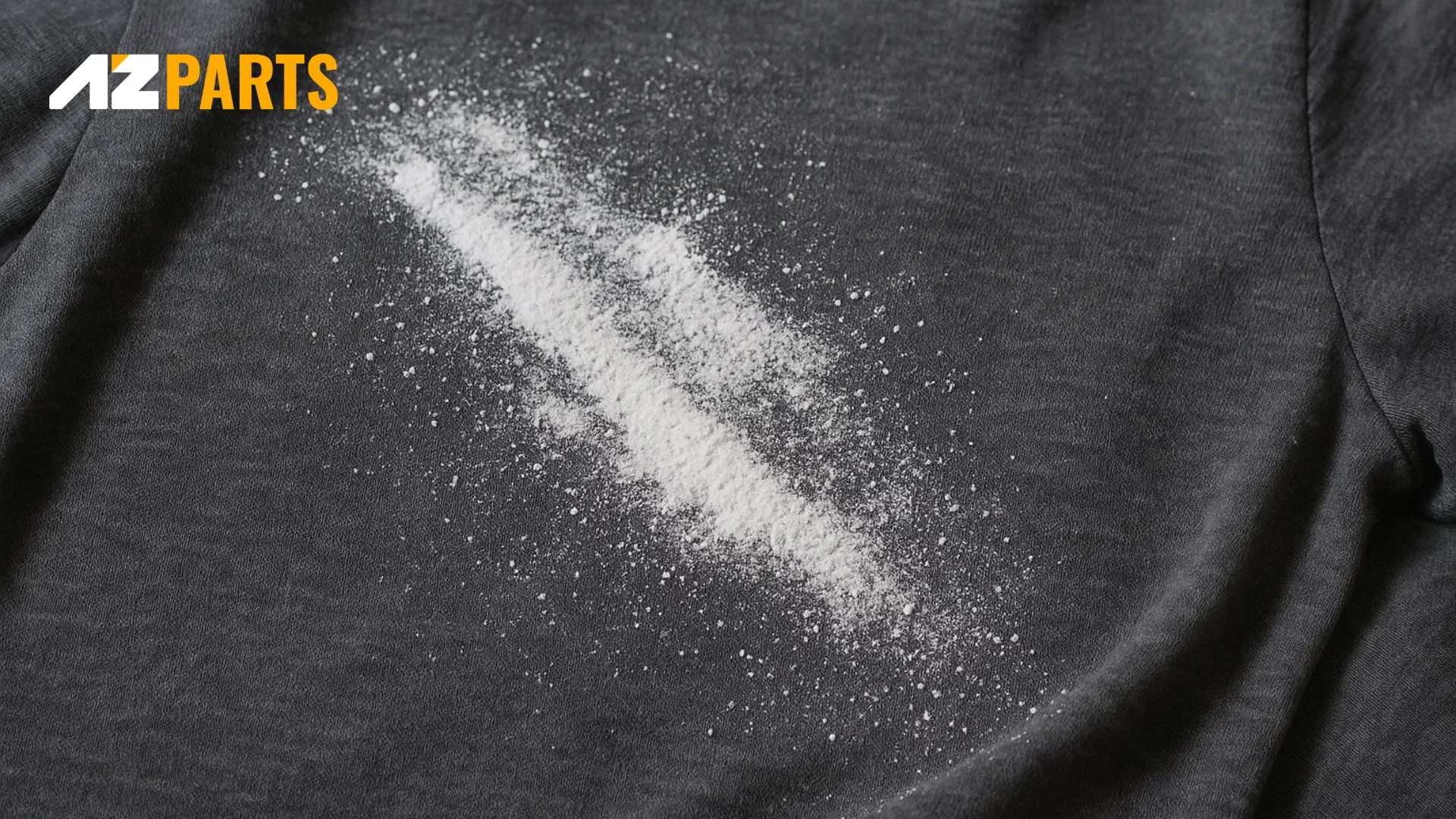
Powder detergents that fail to dissolve completely in wash water create white residue (Source: AZParts)
1.4. Clogged Dispensers
Automatic detergent dispensers can become clogged with dried detergent, fabric softener, or mineral deposits over time. When dispensers are blocked, they cannot release cleaning products evenly throughout the wash cycle, leading to concentrated areas of detergent that don't rinse away properly. Regular cleaning of detergent dispensers prevents buildup and ensures proper product distribution. Remove dispensers monthly and soak them in warm water to dissolve accumulated residue and restore optimal function.
1.5. Too Much Fabric Softener
Excessive fabric softener use creates a waxy buildup on clothes that appears as white residue. Fabric softeners contain conditioning agents that coat fabric fibers to provide softness and reduce static. However, using too much fabric softener can create an excessive coating that doesn't rinse away completely. This buildup not only leaves white residue but also reduces fabric absorbency and can cause skin irritation. Following recommended fabric softener amounts and occasionally skipping fabric softener helps prevent this issue.
1.6. Clogged or Failing Water Pump
A malfunctioning water pump can contribute to white residue problems by preventing proper water circulation and drainage. When the pump struggles to move water effectively, detergent may not distribute evenly or rinse away completely. Pump filters can become clogged with lint, debris, or soap buildup, restricting water flow and compromising wash performance. If you're experiencing consistent white residue issues along with drainage problems, AZParts offers high-quality washer pump filter designed to restore optimal water flow and prevent detergent buildup.
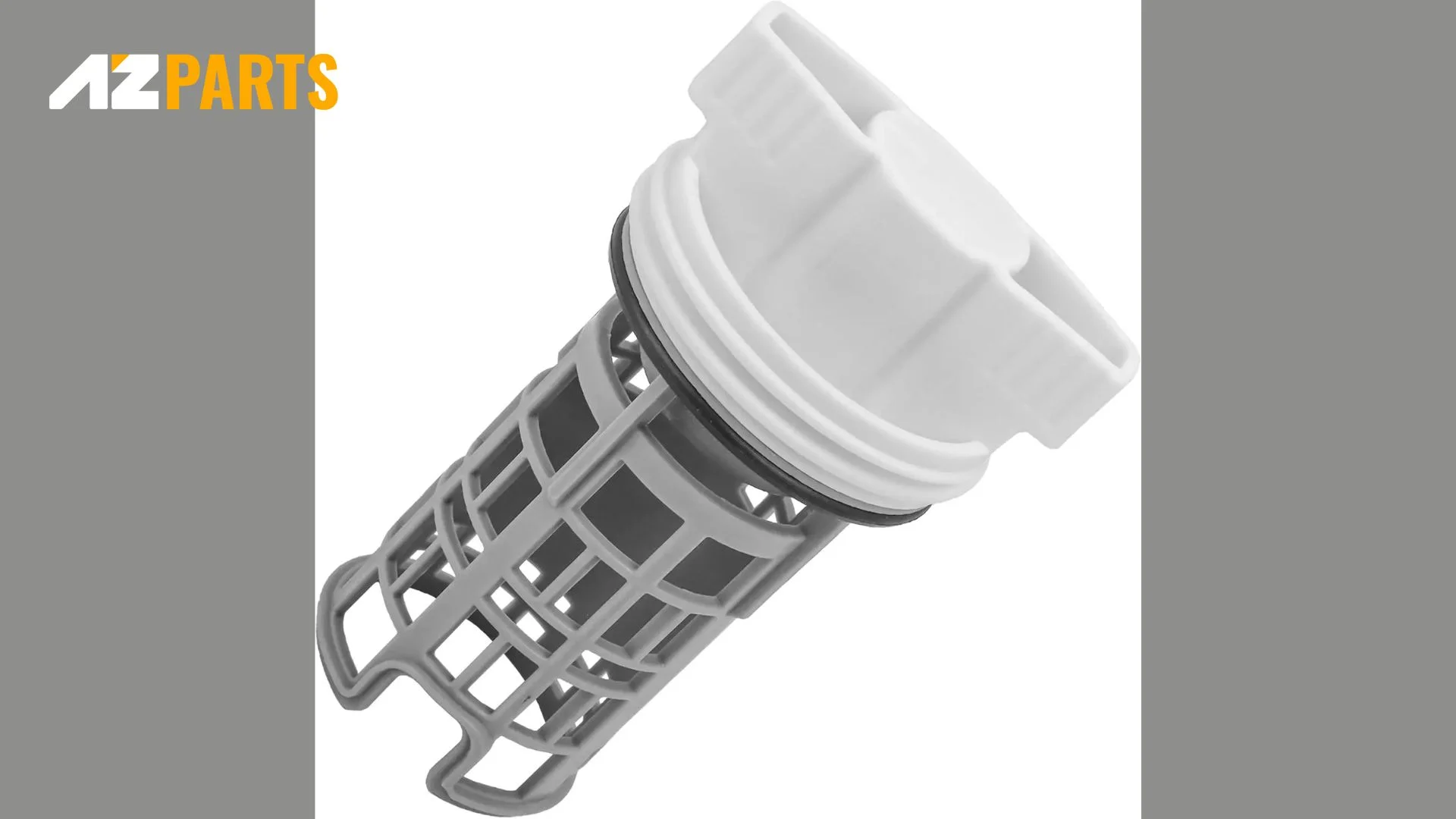
High-quality pump filter parts offered by AZParts (Source: AZParts)
1.7. Dirty Washer
A dirty washing machine cannot effectively clean clothes and often contributes to white residue formation. Soap scum, mineral deposits, and bacteria can accumulate inside the washer drum, dispensers, and internal components. These deposits can break loose during wash cycles and transfer to clothes as white residue. Regular cleaning of your washing machine interior, including the drum, dispensers, and door seals, prevents buildup and maintains optimal performance. Running monthly cleaning cycles with specialized washer cleaners removes accumulated residue and maintains machine hygiene.
1.8. Hard Water
Hard water contains high levels of minerals like calcium and magnesium that interfere with detergent effectiveness. These minerals bind with soap molecules, preventing them from dissolving properly and creating insoluble compounds that appear as white residue on clothes.
Hard water also causes mineral deposits to build up inside washing machines, further complicating the cleaning process. Installing a water softener system or using detergents specifically formulated for hard water conditions helps prevent mineral-related residue problems.
1.9. Using the Wrong Detergent
Different washing machines require specific types of detergents for optimal performance. High-efficiency washers need low-sudsing detergents that produce fewer bubbles and rinse away more easily. Using regular detergent in HE machines can create excessive suds that don't rinse completely, leaving white residue on clothes.
Similarly, using liquid detergent in very cold water may not provide adequate cleaning power, while powder detergents may not dissolve properly in cold temperatures. Selecting the appropriate detergent type for your machine and water conditions prevents residue formation.
1.10. Body Soils
Natural body oils, deodorants, and antiperspirants can react with detergent to create white residue on clothes. These substances often contain aluminum or other compounds that bind with soap molecules, forming insoluble deposits that appear as white streaks or stains.
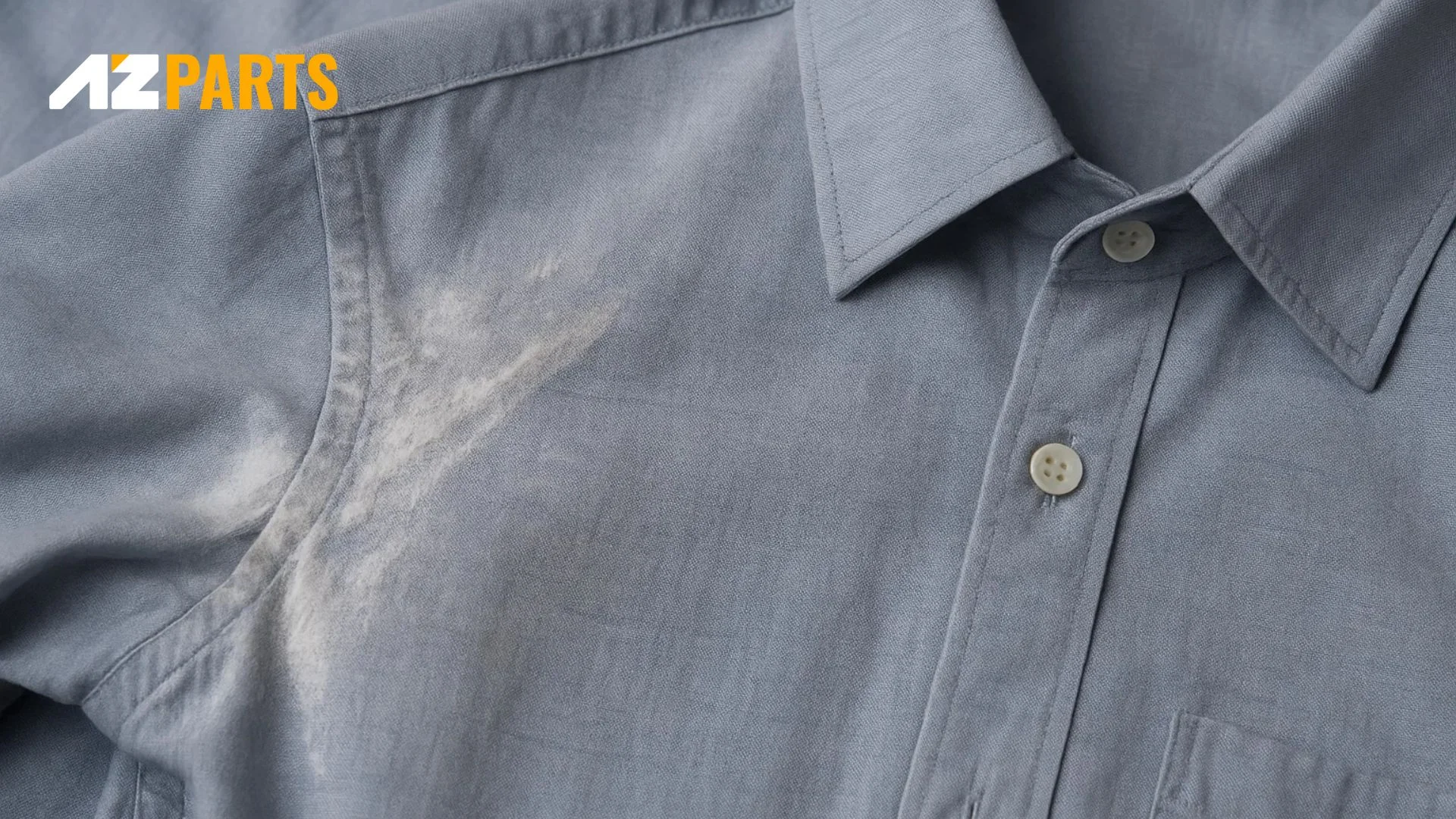
Natural body oils can react with detergent to create white residue (Source: AZParts)
This type of residue commonly appears on shirts around the collar and underarm areas. Pre-treating heavily soiled areas with stain removers or enzyme-based cleaners before washing helps break down these compounds and prevents residue formation.
2. How to Get Rid of White Residue on My Clothes After Washing?
Removing white residue from clothes requires different approaches depending on the type of residue present. For detergent residue, rewashing clothes in hot water without adding any detergent often dissolves and removes the buildup.
Adding one cup of white vinegar to the rinse cycle helps break down soap residue and mineral deposits. For fabric softener buildup, wash clothes in hot water with one cup of baking soda, which neutralizes the waxy coating and restores fabric absorbency.
Stubborn residue may require multiple treatment cycles. Create a paste using equal parts baking soda and water, then rub it into affected areas before rewashing. For mineral deposits from hard water, soak clothes in a solution of equal parts white vinegar and water for 30 minutes before rewashing.
Commercial residue removers are also available for persistent problems, but always test them on inconspicuous areas first to ensure they won't damage fabric colors or textures.
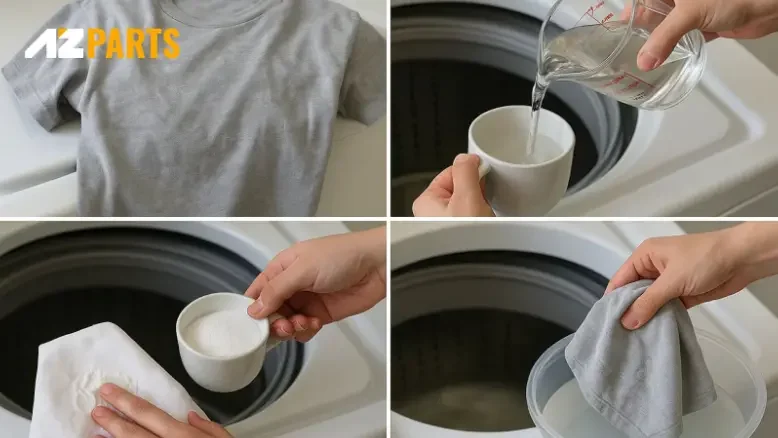
How to Get Rid of White Residue on My Clothes After Washing? (Source: AZParts)
3. Tips to Prevent Laundry Detergent Residue
- Use proper detergent amounts - Follow manufacturer dosage charts based on load size, water hardness, and soil level. Choose appropriate water temperature for your detergent type, as powder detergents need warmer water to dissolve completely.
- Maintain your washing machine regularly - Clean detergent dispensers monthly and run cleaning cycles to remove soap scum and mineral deposits. Check and replace water pump filters as needed for proper water circulation.
- Address hard water issues - Consider installing a water softening system or use detergents specifically formulated for hard water conditions if your home has mineral-rich water.
- Avoid overloading the washer - Ensure adequate space for proper water circulation and thorough rinsing to prevent detergent residue from remaining on clothes.
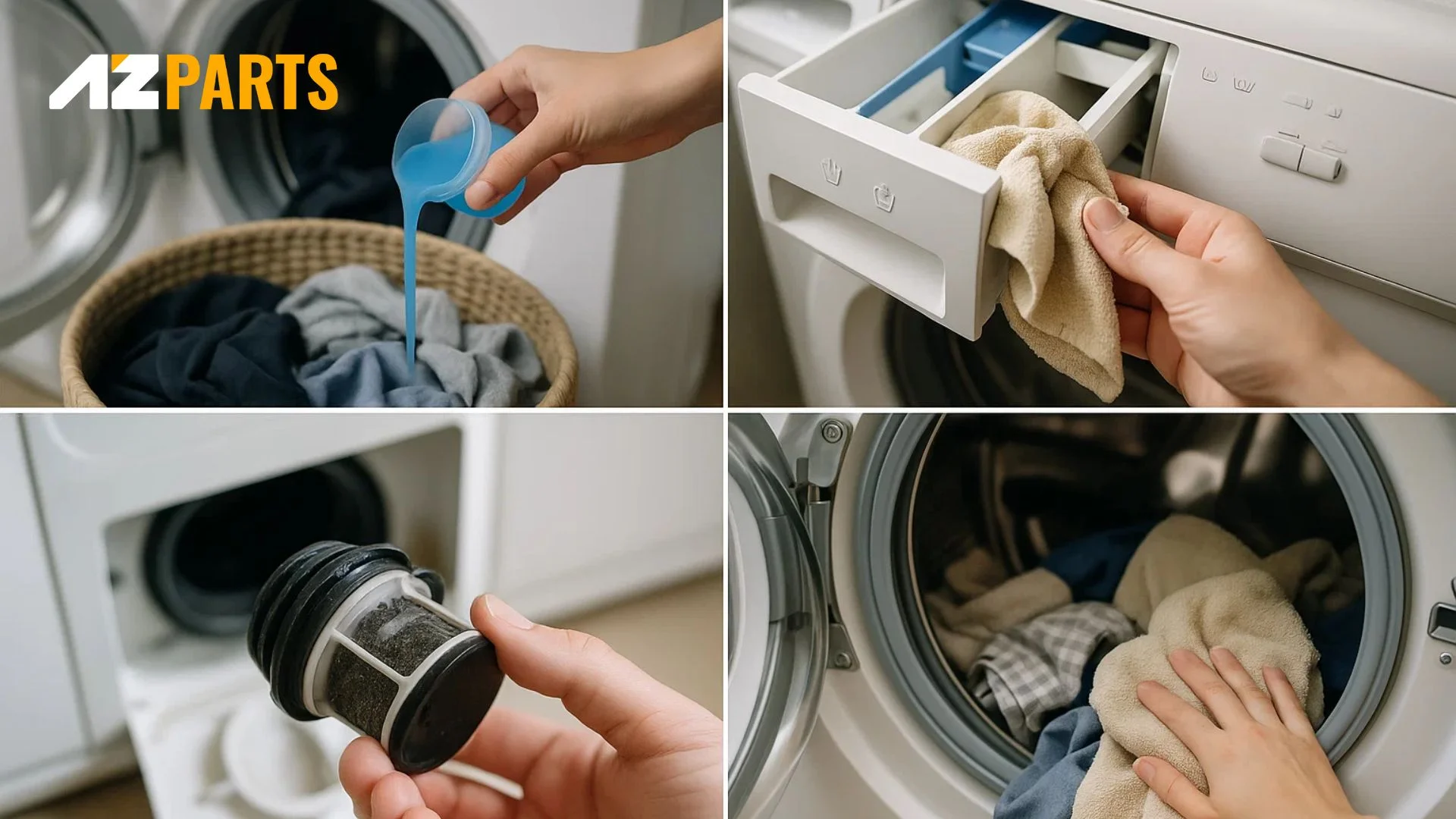
Tips to prevent laundry detergent residue (Source: AZParts)
4. Can White Detergent Residue Permanently Stain Clothing?
White detergent residue typically does not cause permanent staining when addressed promptly. Most residue consists of soap, fabric softener, or mineral deposits that can be removed with proper treatment techniques.
However, allowing residue to build up over multiple wash cycles can make removal more challenging and may cause fabric damage. Fabric softener buildup can reduce fabric absorbency and create a waxy coating that attracts dirt and oils, leading to dingy appearance over time.
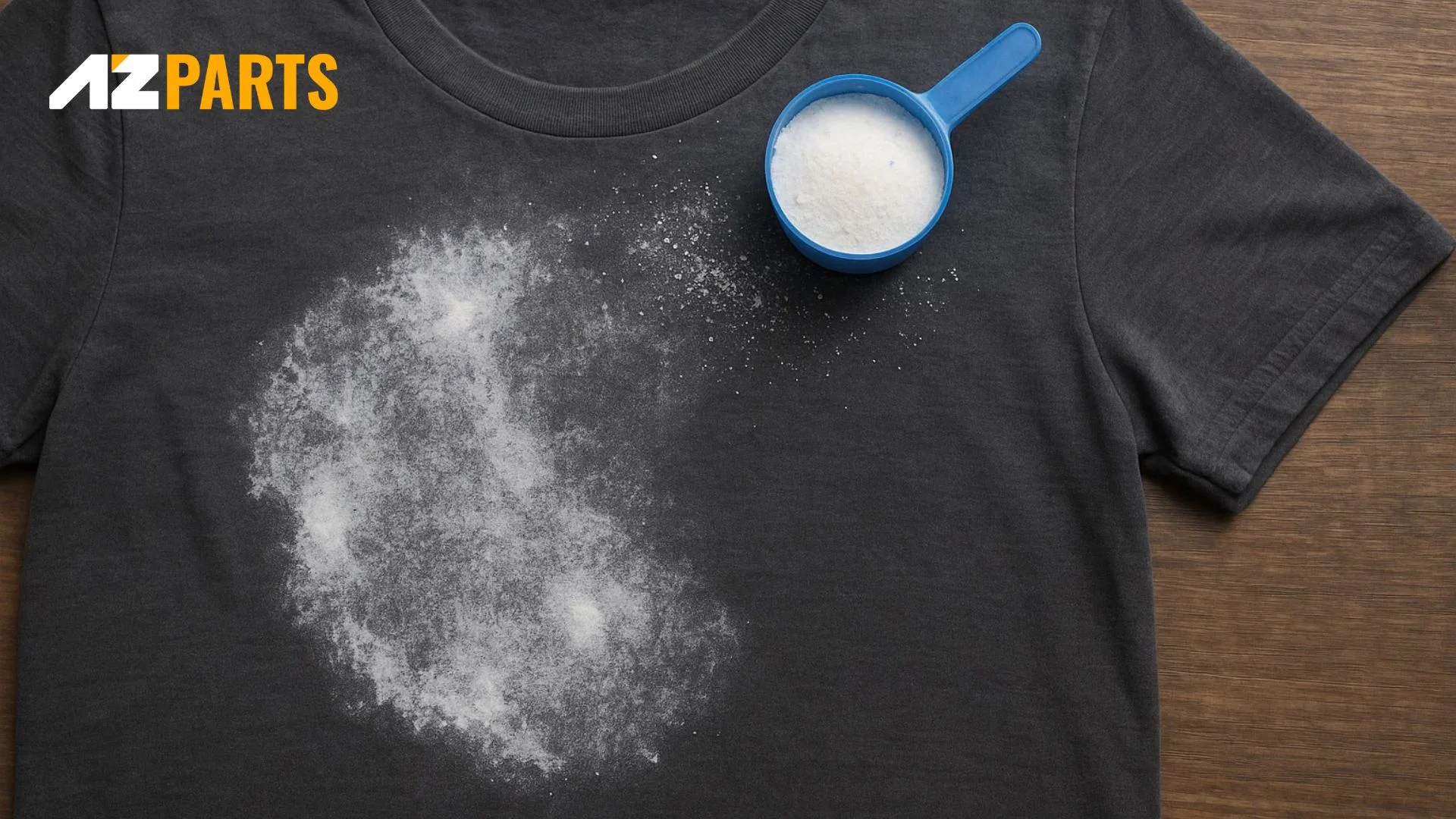
Can white detergent residue permanently stain clothing? (Source: AZParts)
Certain fabric types are more susceptible to residue damage than others. Synthetic fabrics like polyester and nylon tend to attract and hold onto soap residue more readily than natural fibers. Dark-colored fabrics show white residue more prominently, making the problem more noticeable. While most residue can be removed with proper treatment, prevention remains the best approach to maintaining fabric quality and appearance.
5. How Often Should I Clean The Washer?
Clean your washing machine monthly with specialized cleaner or white vinegar mixed with hot water. Run a complete wash cycle to remove soap scum, mineral deposits, and bacteria, then wipe down the drum, door seals, and dispensers. For heavy use or hard water areas, increase cleaning frequency to every two weeks.
Weekly maintenance includes leaving the washer door open after use and cleaning the lint filter. Always wipe detergent dispensers after each load to prevent clogging. This simple schedule prevents buildup and maintains optimal washing performance.
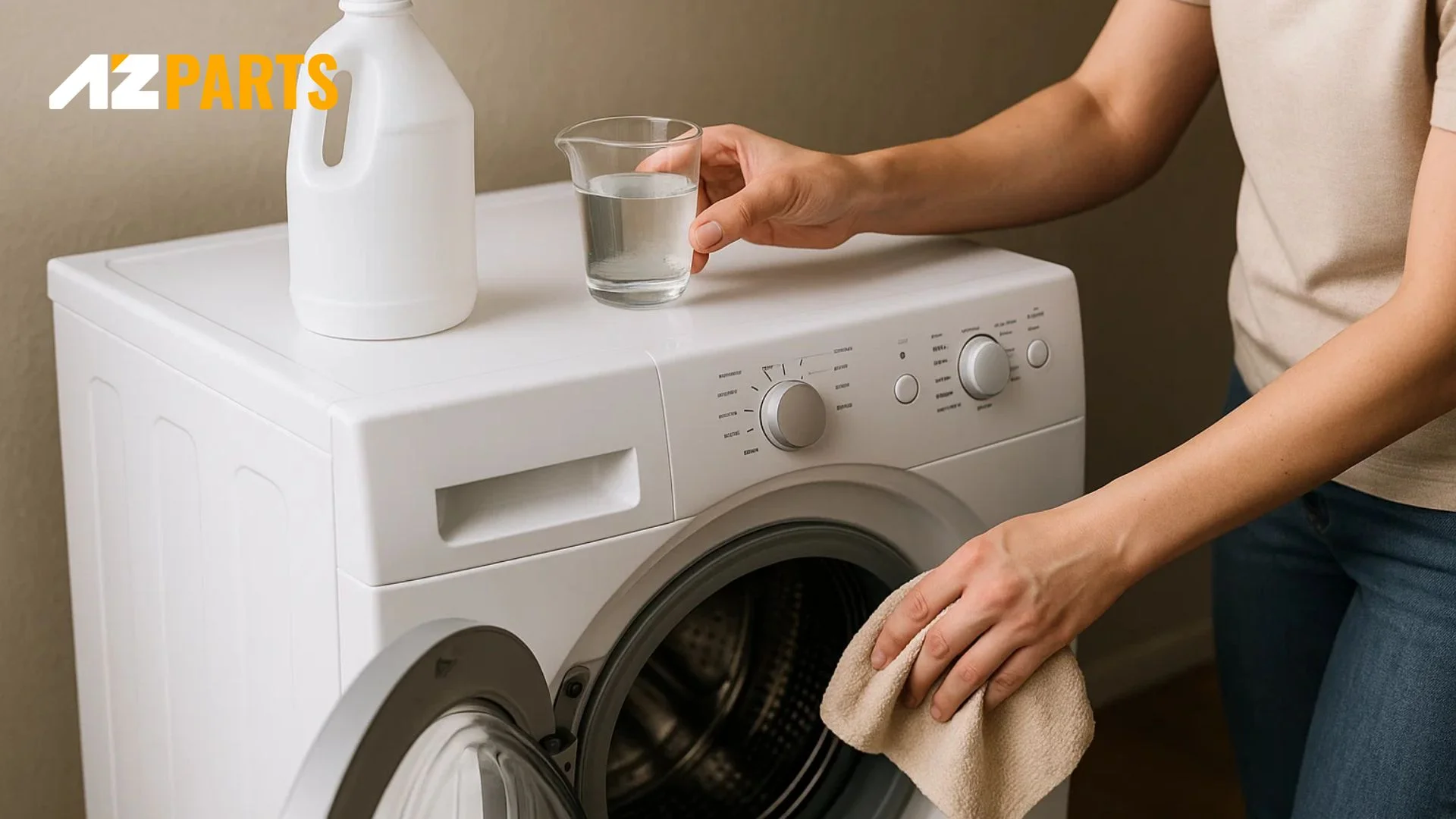
How often should you clean the washer? (Source: AZParts)
White residue after washing clothes results from various factors including excessive detergent use, hard water conditions, and inadequate machine maintenance. Understanding these causes enables you to implement effective prevention strategies and maintain clean, fresh-smelling laundry. Regular washing machine cleaning, proper detergent usage, and quality replacement parts from AZParts help ensure optimal performance and prevent residue problems.
Don't let white residue ruin your laundry experience. Explore our comprehensive selection of washing machine parts and maintenance solutions at AZParts today to keep your appliances running smoothly and your clothes looking their best.
Contact Information:
8 The Green, Ste A, Dover, Delaware 19901-3618, United States
Learn more about other common washer issues and how to fix them:
Washer
Further Reading
Further Reading


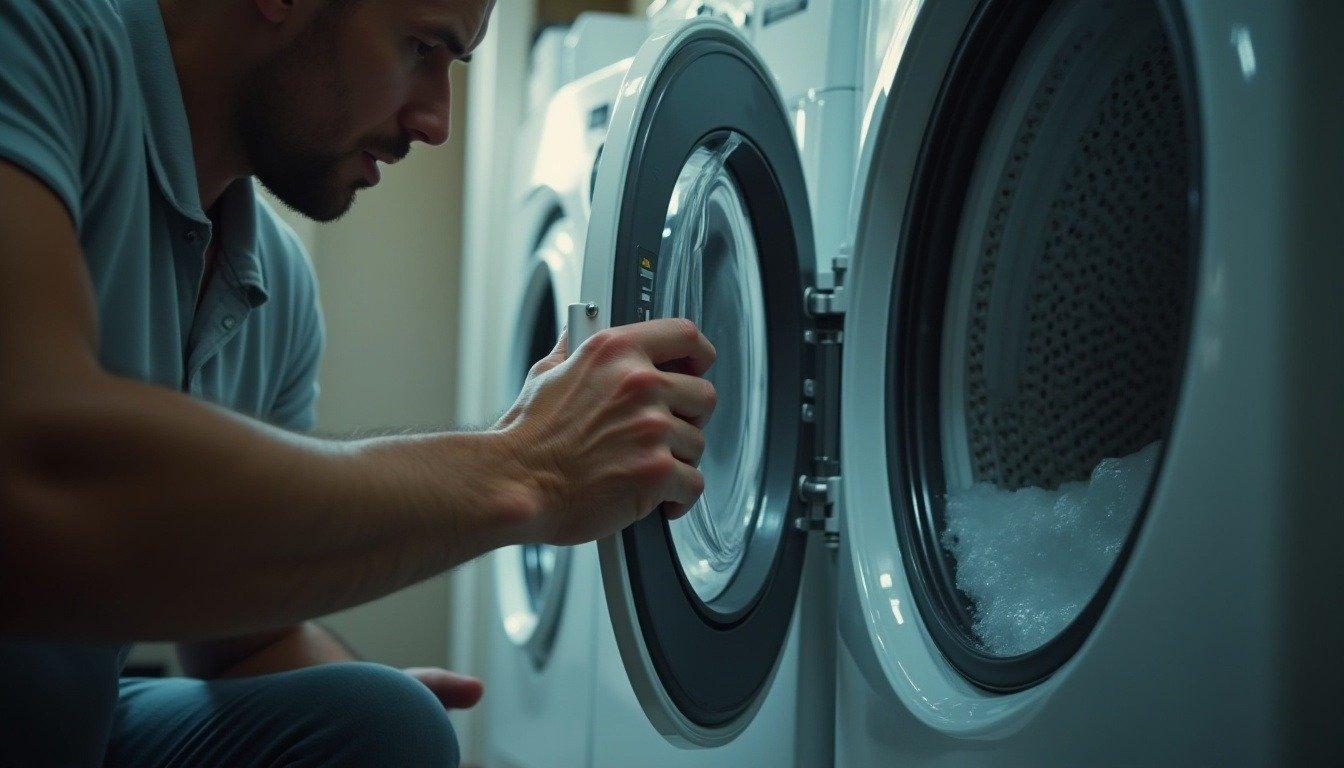


_1748341252.jpg&w=3840&q=75)